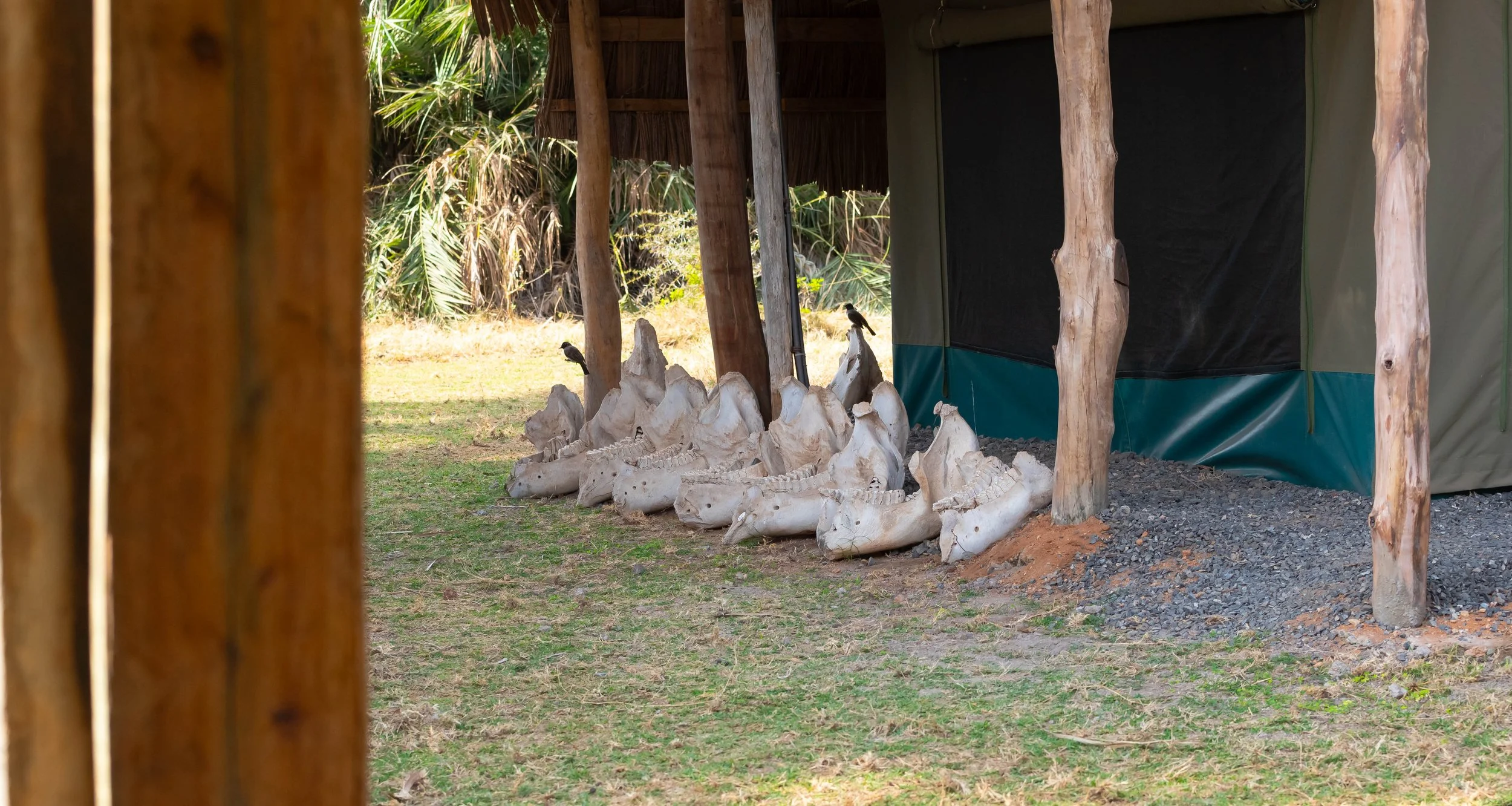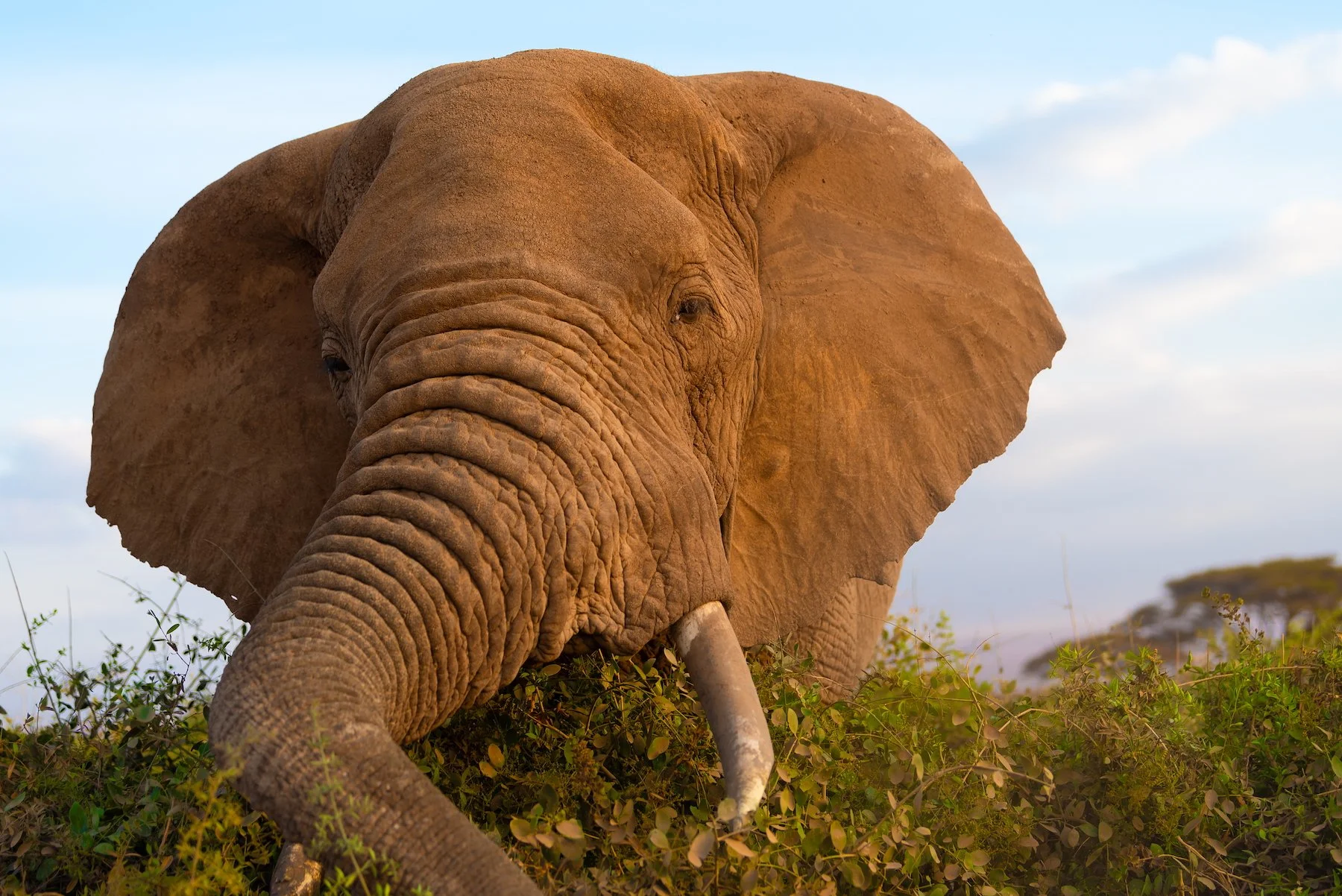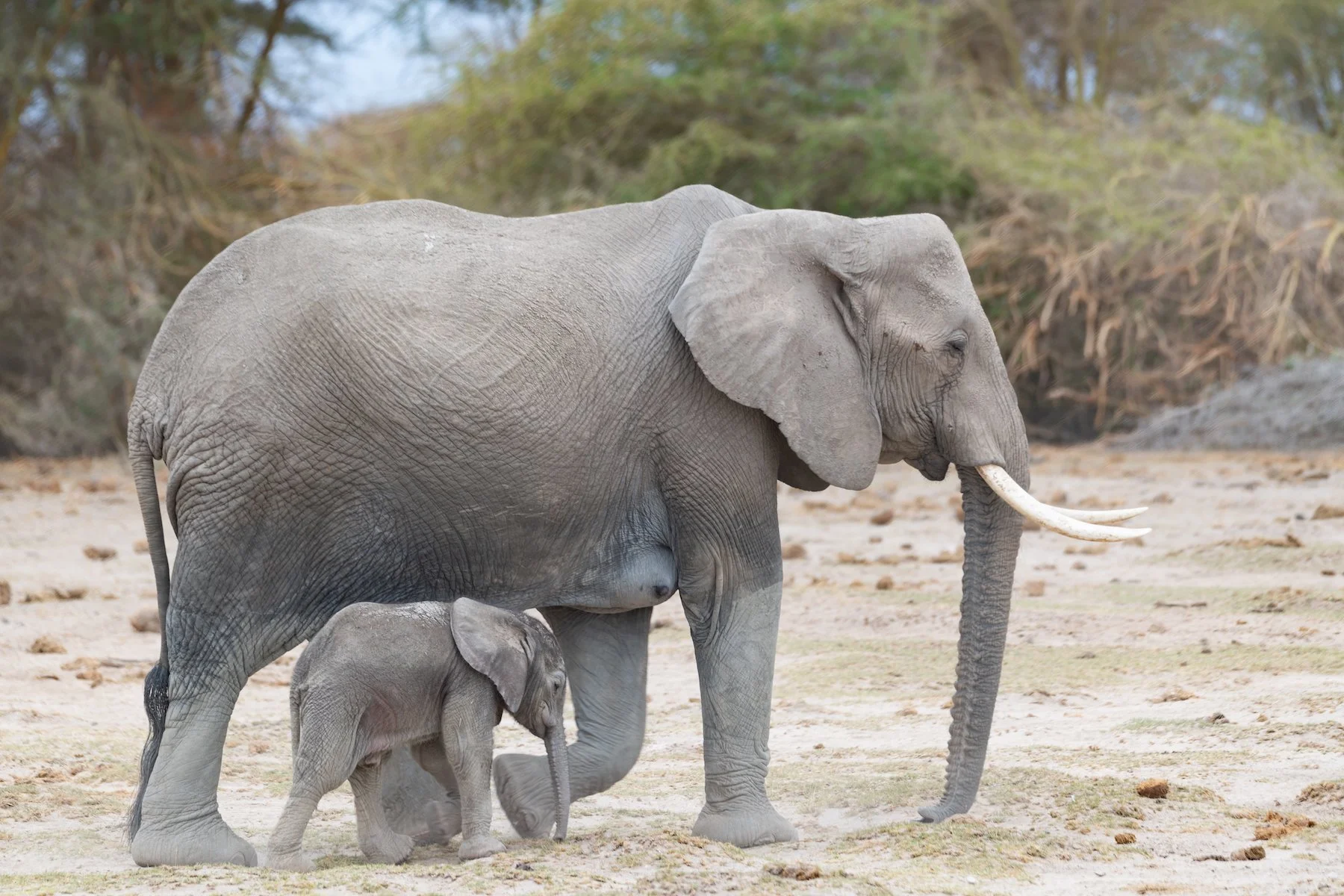Amboseli
Amboseli, Kenya is home to world famous elephants, thanks to a research project that began in 1972.
The entrance to Amboseli Trust for Elephants, a research organization, was hidden from the main road. We took a side road, and on the other side of some trees, we found ourselves in a small camp of several small buildings. Norah Njiraini greeted us with a warm smile and led us to an outdoor table. She brought us water to knock off the heat of the day. Norah is a researcher at Amboseli Trust for Elephants.
We sipped our drinks and talked with her about our plan to write a book about elephants and to share the profits among several elephant conservation groups including Amboseli Trust for Elephants. She then began to unfold a wealth of information about elephants and about Amboseli. “Amboseli” means “salty dust”. Water from the melting snows from Mt. Kilimanjaro makes its way down through the soil to Amboseli where it comes up through the soil. So the animals who come there are happy with the abundant minerals in the water there. Nora explained that the swamps in Amboseli have been getting bigger and bigger, which then become a haven for elephants and other animals. It was in the midst of a drought when we were visiting with her and animals were more scarce, but in 2019, on our previous visit, Amboseli was teaming with hippos, wildebeest, birds, gazelles, and of course, elephants.
Dr. Cynthia Moss and Harvey Croze founded Amboseli Elephant Research Project in 1972. In the year 2000, Amboseli Trust for Elephants was established as a legal entity. The research that Cynthia Moss and her later fellow researchers have done on elephants became the source of baseline data for Amboseli Trust for Elephants, which continues to fund that research and provides outreach to develop close relationships with the Maasai communities who live in and around Amboseli.
Cynthia Moss wrote an excellent book, Elephant Memories, which touched my heart profoundly.
In this book and several others, Moss writes about her research and the many elephant families that she identified by their ears and the shape of their bodies, identified the families, named the elephants, and followed them over the years. Norah explained to us the way in which elephant research is done. She and her colleagues go out observing in their vehicles daily, noting the demographics, siting and recording and photographing which elephants they are finding and where, monitoring what they are doing and where they are going, as well as the presence of musth males (those who are in their reproductive prime) and who they are mating.
This research has been ongoing for over 50 years and has included as many as 4000 elephants.
Norah described the life cycle of elephants to us that the researchers have observed. She described how elephants move in families of grandmothers, mothers, cousins, sisters, with the oldest, the matriarch at the head of the family. The family waits for the matriarch to decide where to go. In Amboseli, the families range over a large area that covers Amboseli National Park and surrounding community owned and inhabited land. The elephants move freely, spending their days inside the Park and evenings in community owned land.
The female children come in estrous at age 8 to 9 years and remain in estrous for 4 to 6 days every month until they conceive, with their first babies being born between 11 and 14 years of age. The females suckle their calves until the next calf comes along, every 3 to 5 years. The male children remain with the maternal family until 10 to 15 years of age. The matriarch has to let them know sometimes if they are mama’s boys and do not want to leave. When they do leave, they may stay with another family before joining a male group or going out on their own.
Males come into musth, that is, coming into their reproductive prime, in their late 20s to early 30s. As they get older, they get stronger and bigger, stay reproductively active, and look for estrous females. In the process, they may fight other males to establish the right to mate the females, although it is extremely rare for them to fight to the death.
Elephants die because of starvation when they are quite old and their teeth have worn down to the point that they can no longer chew the vegetation. After a matriarch dies, the second oldest female elephant may take over. But sometimes it is the daughter of the matriarch that becomes the next matriarch. Sometimes the females fight when the matriarch dies. And sometimes the family may split up if it is large, usually following ancestral lineages. When a matriarch dies, females may choose to follow different leaders.
When elephants die, Norah indicated that the researchers contact Kenya Wildlife Service, who comes to collect the ivory tusks, so as to discourage poaching. Then the researchers may bring the lower jaw to their field camp to determine the elephant’s age when at death. All around this camp, we saw the many lower jaw bones of elephants that had died in Amboseli over the now 50 years since the research began.
The elephants sometimes wander into the grounds there and find the lower jaws of their family members who have died, touch them tenderly, spending some time with them before leaving.
Norah went on to describe the communication and emotions of elephants. She indicated that from observing their behavior, the researchers have been able to identify when elephants are happy, when they are sad, and other emotions. Elephants make a low rumble contact call to other elephants, and the other elephants rumble back a contact answer. In this way, elephants often know the whereabouts of other elephant families, or of more distant family members. Both males and females have a temporal gland between their ears and eyes, along the side of their heads. During male fights, these glands, a part of their endocrine system, secrete liquid, and the males change the way they walk, as if to say, “I’m the guy!” Female elephants also have temporal secretions when they are excited or sad or stressed or have some other form of excitement.
Norah then told us about some of the elephants that we had seen and photographed in Amboseli. Earlier that week, we had had a lengthy encounter with a bull elephant on the other side of a hedge. From our photograph and her books of photographs of the ears of elephants, she was able to tell us that we had found Tor, whose story I have written in Elephant – Part II. She also identified that the mother, with the darling calf I had photographed, both eating white flowers in the soft morning light, was called Zagazig! Zagazig was born in 2004, and that calf was her first calf, under two years old.
It is a magnificent experience to find out an elephant you have fallen in love with has a name!
Norah also told us about her favorite elephant, “Ian”, who was such a lovely elephant that she named her son after him!
Norah also told us a story about an encounter with “Bad Bull”.
“Bad Bull” was a large bull who kept charging researchers. He became very aggressive, as males often do, when he was in musth. When the researchers would go near him, he would pretend to be moving, then charge. When an elephant wants to charge, if it is just trying to scare someone or some animal off, it will come straight at you, swinging its head and making light of it. But when he's serious, they come straight at you with head down and tusks down ready to do their work. Norah described how one June, July, and August, “Bad Bull” came into musth. She was working with another researcher, Joyce, who was studying elephant sounds. They drove past “Bad Bull” two times, trying to identify him and the “EB” family. When they found the “EB” family, they turned off the engine and recorded the elephant sounds. Norah said she had a funny feeling, and when she looked in the mirror, she saw “Bad Bull”. She could not drive forward, nor go sideways. She could only go in reverse, but by then he was really close behind the vehicle. He stayed there for 20 minutes while they waited for him to do what he was going to do. Both Norah and Joyce were shaking. Finally he left.
She said it seemed like he wanted to show us that he was really not so bad. She came home and went straight to bed – such an unnerving experience, even for a seasoned elephant researcher!
Norah concluded with telling us that, “Elephants are so smart. They know our smell and our sound.” She told us about how Cynthia Moss and an elephant named “Echo” had very special feelings between them. Once when Cynthia was feeling poorly and was in bed in camp, “Echo” came into camp looking for her, and came to her tent. Elephants are very affectionate. Cynthia’s wonderful story about “Echo” can be found in her book, Echo of the Elephant Family.
Sadly, human beings are one of an elephant’s biggest enemies, along with drought.
Elephants require a great deal of food and water and therefore room to roam.
As the human population grows, the land becomes subdivided, and this can threaten elephant survival. In Amboseli, Norah told us that Maasai bring their cattle to drink and graze, so that they are competing with elephants for food. Once there is a drought, as there was in 2022 when we met with Norah, the competition is more serious. The moms and babies that we saw among the elephants in Amboseli during the drought were thin and not properly nourished, slower moving than this slow moving species usually is.
But there are also stories of a kinder relationship between humans and elephants. Norah told of a female named “Laura” who was stuck in a hole. Humans put straw and logs in the hole so that she could come up. When she finally came up, she turned to the group of humans who had helped her, swung her trunk and then went off as if to say, “Thank you!”
You can be one of the human beings on the planet that helps out elephants.
Amboseli Trust for Elephants relies entirely on donations from people like you and me. They work closely with the Kenya Wildlife Service, but they are a research group and do not receive any monies from Kenya Wildlife Service nor from any governmental agency. And they carry on outstanding research about elephants, learning by watching, recording, and loving these intelligent, emotional creatures.
Below is a link to donate to this incredible organization. Not only do they study elephants; they also provide more than 60 scholarships for Maasai women and men. They are also involved in creating a cooperative community with the Maasai including livestock consolation money for situations in which they have lost livestock to an elephant, Maasai elephant scouts working throughout Amboseli, scholarships to schools, and local and regional training programs. And then Amboseli Trust for Elephants has their Elatia Project in which you can follow an elephant family for a year, hearing all the details of their stories and daily dramas. Click below to learn more and to donate.
Link to: https://www.elephanttrust.org
Will you join me in learning about and donating to the incredible work at Amboseli Trust for Elephants?
Will you consider following an elephant family for a year?
Will you help out the Maasai community there so that both elephants and the human community can survive and thrive together?
If not now, when?










